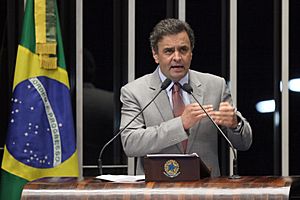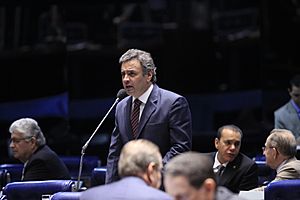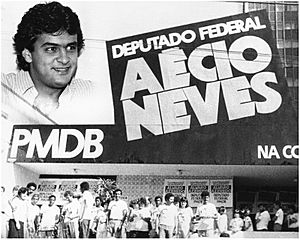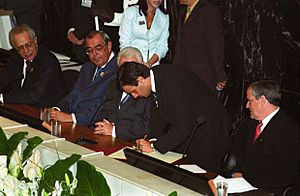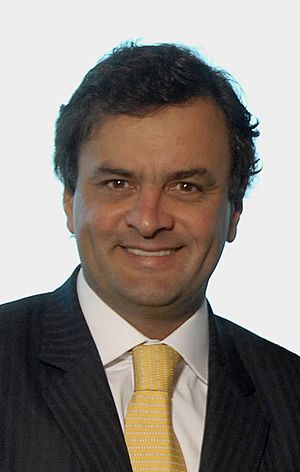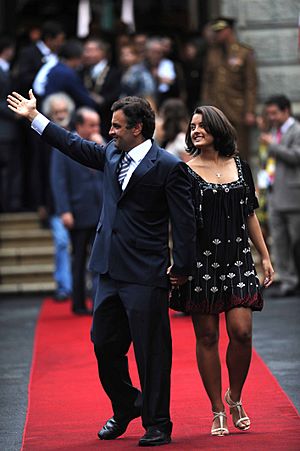Aécio Neves facts for kids
Quick facts for kids
Aécio Neves
|
|
|---|---|
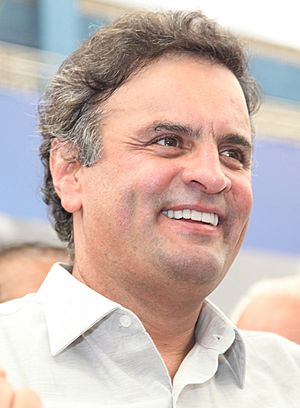
Neves in 2014
|
|
| Senator for Minas Gerais | |
| In office 1 February 2011 – 1 February 2019 |
|
| National President of the Brazilian Social Democracy Party | |
| In office 18 May 2013 – 18 May 2017 |
|
| Preceded by | Sérgio Guerra |
| Succeeded by | Tasso Jereissati (Acting) |
| Governor of Minas Gerais | |
| In office 1 January 2003 – 31 March 2010 |
|
| Vice Governor | Clésio Andrade (2003–07) Antônio Anastasia (2007–10) |
| Preceded by | Itamar Franco |
| Succeeded by | Antônio Anastasia |
| President of the Chamber of Deputies | |
| In office 14 February 2001 – 17 December 2002 |
|
| Preceded by | Michel Temer |
| Succeeded by | João Paulo Cunha |
| Federal Deputy for Minas Gerais | |
| Assumed office 1 February 2019 |
|
| In office 1 February 1987 – 17 December 2002 |
|
| Chair of the Chamber Foreign Affairs and National Defence Committee | |
| Assumed office 12 March 2021 |
|
| Preceded by | Eduardo Bolsonaro |
| Personal details | |
| Born |
Aécio Neves da Cunha
10 March 1960 Belo Horizonte, Minas Gerais, Brazil |
| Political party | PSDB (1988–present) |
| Other political affiliations |
PMDB (1980–88) |
| Spouses |
Andréa Falcão
(m. 1991; div. 1998)Letícia Weber
(m. 2013) |
| Children |
|
| Alma mater | Pontifical Catholic University of Minas Gerais (B.Ec.) |
Aécio Neves da Cunha (born March 10, 1960) is a Brazilian economist and politician. He was the Governor of Minas Gerais state from 2003 to 2010. He also served as a Senator and is currently a member of the Brazilian Chamber of Deputies. In 2014, he ran for president but lost to Dilma Rousseff.
Contents
A Politician's Journey
Aécio Neves was born in Belo Horizonte, the capital city of Minas Gerais. He became the youngest governor in the state's history. His political journey began when he worked as a personal secretary for his grandfather, Tancredo Neves. Tancredo Neves was elected President of Brazil in 1985 but sadly passed away before he could take office.
Aécio Neves served four terms as a federal deputy for the Brazilian Social Democracy Party (PSDB). He represented Minas Gerais in the Federal Chamber of Deputies from 1987 to 2002. He was also the President of the Chamber of Deputies from 2001 to 2002.
As governor, Aécio Neves started a program called "Management Shock." This program aimed to control the state's budget by reducing government spending. It also encouraged new investments. In 2010, he decided not to run for president and instead became a Senator for Minas Gerais. He started his term as Senator on February 1, 2011.
In 2014, Aécio Neves ran for president of Brazil. He received the second-highest number of votes in the first round. This meant he went to a second round of voting against Dilma Rousseff. He lost the election on October 26, 2014.
Early Life and Family
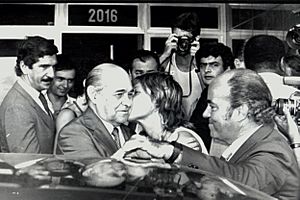
Aécio Neves comes from a family with a long history in politics in Minas Gerais. His mother's father, Tancredo Neves, was very important in Brazil's return to democracy. He was also a governor of Minas Gerais. Aécio's father, Aécio Cunha, and his father's father, Tristão Ferreira da Cunha, were also congressmen.
When Aécio was 10, his family moved to Rio de Janeiro. He later studied economics at the Pontifical Catholic University of Minas Gerais. In 1982, he helped his grandfather, Tancredo Neves, in his campaign to become governor of Minas Gerais. After Tancredo won, Aécio worked as his private secretary.
Aécio also took part in the "Diretas Já" movement, which pushed for direct presidential elections. He joined his grandfather on trips to other democratic countries. These trips were important for Brazil's return to democracy. They met leaders like US President Ronald Reagan and French President François Mitterrand.
Serving in Congress
In 1986, Aécio Neves was elected to the National Constituent Assembly. He received many votes, showing strong support from Minas Gerais. In the Assembly, he helped write an important change that allowed 16-year-olds to vote in Brazil.
He was reelected to Congress several times. In 1992, he ran for mayor of Belo Horizonte but was not elected. This was his only election loss until the 2014 presidential race. In 1997, he became the leader of his party, PSDB, in Congress.
Leading the Chamber of Deputies
In 2001, Aécio Neves was elected President of the Chamber of Deputies. He won with more votes than all his opponents combined. He served as president from February 14, 2001, to December 17, 2002. During this time, he even temporarily became the President of Brazil on June 26, 2001.
As president, he introduced new rules to make parliamentary actions more ethical. He also made it possible for the public to follow legislative processes online. He worked to reduce spending in Congress and returned the saved money to the government.
As a Senator
On October 3, 2010, Aécio Neves was elected Senator for Minas Gerais. He worked on committees related to political reform, constitutional affairs, and justice. As a Senator, he supported ideas like reducing taxes and changing how mining royalties were calculated.
In 2017, there were discussions about his position as Senator. The Federal Senate later voted to allow him to return to his seat.
Key Achievements as Governor
Aécio Neves was elected governor of Minas Gerais on October 6, 2002. He was reelected in 2006, becoming one of the longest-serving governors in the state's history.
Social Programs
Aécio Neves launched several social programs. One was the Project to Combat Rural Poverty, which helped 188 towns in Northern Minas Gerais. Communities decided how to use the funds for projects like building kindergartens or starting fish farms.
He also started the Youth Savings Program in 2007. This program helped high school students from areas with high social risks. Students who met certain goals, like good attendance and grades, received money at the end of high school. This money could help them with their future careers. Over 30,000 students took part in this program.
Improving Transportation
In 2004, the Neves government created a program to pave roads. This program connected 225 towns that previously only had dirt roads. This made travel and transportation much easier for people in those areas.
Administrative City Tancredo Neves
Aécio Neves oversaw the building of the Administrative City Tancredo Neves. This new complex became the headquarters for the State Government. It was opened on March 4, 2010, on what would have been his grandfather Tancredo Neves's 100th birthday. The buildings were designed by the famous architect Oscar Niemeyer.
Management Shock Program
A key part of Aécio's time as governor was the "Management Shock" program. This program aimed to make the government more efficient. It focused on reducing government spending and investing more in public services. The program also helped train state employees.
In 2003, he created the "Stay Alive" program to reduce crime rates. This program helped high-risk students and young adults in areas with high crime. It offered workshops on sports, culture, and job skills to keep young people away from crime. In areas where the program was active, crime rates dropped significantly.
Presidential Candidacy in 2014
In December 2012, former Brazilian president Fernando Henrique Cardoso suggested Aécio Neves as a candidate for president in 2014. In the election, Neves came in second place in the first round of voting. He then went to a second round against the current president, Dilma Rousseff. He lost the election on October 26, 2014, with 48.4% of the votes to Rousseff's 51.6%.
Personal Life
Aécio Neves was born in 1960 into a political family in Belo Horizonte.
He married Letícia Weber in 2013. They had twins, Bernardo and Julia, in September 2014. He also has another daughter, Gabriela, from his first marriage.
Elections
| Year | Election | Party | Office | Coalition | Partners | Party | Votes | % | Result | Ref. | ||
|---|---|---|---|---|---|---|---|---|---|---|---|---|
| 1986 | State Elections in Minas Gerais | PMDB | Federal Deputy | None | 236,019 | - | Elected | |||||
| 1990 | PSDB | None | 42,412 | - | Elected | |||||||
| 1994 | None | 105,385 | 2.17% | Elected | ||||||||
| 1998 | None | 185,051 | 2.57% | Elected | ||||||||
| 2002 | Governor | United Minas
(PSDB, PFL, PPB, PV, PSL, PTN, PAN, PRTB, PHS) |
Clésio Andrade | PFL | 5,282,043 | 57.68% | Elected | |||||
| 2006 | Governor | Minas Cannot Stop
(PSDB, PFL, PP, PL, PSB, PTB, PPS, PSC, PAN, PHS) |
Antonio Anastasia | PSDB | 7,482,809 | 77.03% | Elected | |||||
| 2010 | Senator | We are Minas Gerais
(PSDB, PP, DEM, PR, PSB, PDT, PTB, PPS, PSC, PMN, PSDC, PSL) |
Elmiro Nascimento | DEM | 7,565,377 | 39.47% | Elected | |||||
| Tilden Santiago | PSB | |||||||||||
| 2014 | Brazilian Presidential Election | President | Change Brazil
(PSDB, SD, PMN, PEN, PTN, PTC, DEM, PTdoB, PTB) |
Aloysio Nunes | PSDB | 34,897,211 | 33.55% | Second Round | ||||
| 51,041,155 | 48.36% | Lost | ||||||||||
| 2018 | State Elections in Minas Gerais | Federal Deputy | None | 106,702 | 1.08% | Elected | ||||||
| 2022 | None | 85,341 | 0.76% | Elected | ||||||||
See also
 In Spanish: Aécio Neves para niños
In Spanish: Aécio Neves para niños


